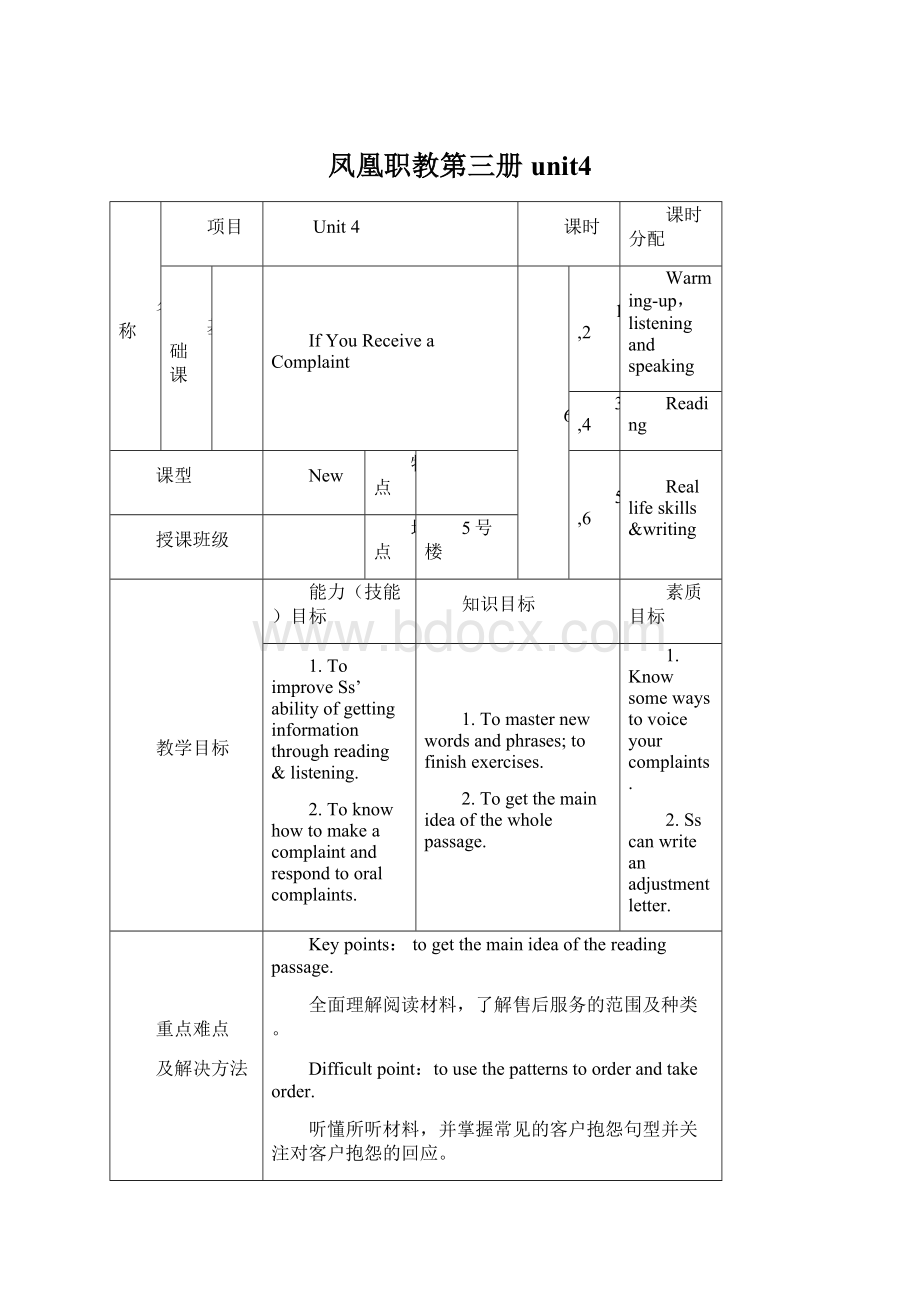凤凰职教第三册unit4.docx
《凤凰职教第三册unit4.docx》由会员分享,可在线阅读,更多相关《凤凰职教第三册unit4.docx(27页珍藏版)》请在冰豆网上搜索。

凤凰职教第三册unit4
名称
项目
Unit4
课时
课时分配
基础课
IfYouReceiveaComplaint
6
1,2
Warming-up,listeningandspeaking
3,4
Reading
课型
New
特点
5,6
Reallifeskills&writing
授课班级
地点
5号楼
教学目标
能力(技能)目标
知识目标
素质目标
1.ToimproveSs’abilityofgettinginformationthroughreading&listening.
2.Toknowhowtomakeacomplaintandrespondtooralcomplaints.
1.Tomasternewwordsandphrases;tofinishexercises.
2.Togetthemainideaofthewholepassage.
1.Knowsomewaystovoiceyourcomplaints.
2.Sscanwriteanadjustmentletter.
重点难点
及解决方法
Keypoints:
togetthemainideaofthereadingpassage.
全面理解阅读材料,了解售后服务的范围及种类。
Difficultpoint:
tousethepatternstoorderandtakeorder.
听懂所听材料,并掌握常见的客户抱怨句型并关注对客户抱怨的回应。
教学策略
与方法
结合学生专业特色,创设生动的工作情境,让学生在模拟的工作场景中学会做一名优秀的售后服务人员。
教学资料
及教学准备
Exercisebookandstudents’books
TestpapersSomeexamplesentences
板书设计
UnitFour
Newwordsandexpressions:
languagepoints:
教学后记
本单元围绕售后服务过程中可能遇到的各种情况,结合学生专业特色,创设生动的工作情境,让学生通过阅读投诉信和电话投诉等方式,了解售后服务的范围及种类,并能够回应口头投诉,能够阅读各种投诉信,通过讨论各种投诉方式,确定如何处理顾客投诉。
教学过程
教学程序与内容
教师活动-导
学生活动-演
设计意图
UnitFour
第一课时
(电话投诉)
Warming-up&
SpeakingA
StepOne:
warm-up
T:
Doyouhaveanyproblemsinyourdailylife?
Pleasechoosethecorrectpictureforeachproblembelow.
StepTwo:
lead-in
Createshortconversationabouttheproblemslistedaboveandrole-playwithyourpartner.
StepThree:
listening
Activity1:
extensivelistening
Listentotheconversationandcirclewhatitismainlyabout.
Activity2:
intensivelistening
Listenagain.Thenunderlinethecomplaintsintheconversation.
Activity3:
speaking
Respondtothefollowingcomplaints.
1Apology:
Oh,I’mverysorry.
Action:
I’llcheckyourorderwiththechef.
2Apology:
Oh,I’mreallysorry.
Action:
I’lllettheworkercleanitimmediately.
StepFour:
role-play
Respondtothefollowingcomplaintsandhavearole-play.
StepFive:
summary
Usefulexpressionsaboutcomplaints.
Makingacomplaint:
I’mafraidIhavetomakeaseriouscomplaint.
Acceptingacomplaint:
Oh,I’msorryaboutthat.
Delayingacomplaint:
I’mafraidwecan’thelpyouatthemoment.Couldyouleaveyourphonenumberandaddress?
Wewillcontractyousoon.
Rejectingacomplaint:
Well,I’mafraidthereisn’tmuchwecandoaboutit.
StepSix:
homework
Trytorememberthenewwordsandexpressions.
Notes:
1,waitinline排队等候
2.,breakdown发生故障
e.g.Hiscarbrokedownonhiswaytothecompany.
breakout战争爆发,(火灾)发生
breaktherule/law/record
e.g.Whoeverbreakstheruleswillbepunished.
3,annoyv恼怒,使生气
e.g.beannoyedwithsb.forsth./atsth.对某人为某事生气
e.g.Theteacherwasannoyedwithhimforhisbeinglate.老师因为他的迟到而生他的气。
4,havetrouble(in)doing做某事有困难
havedifficulty(in)doing
haveahardtime(in)doing
e.g.Nowadayscollegegraduateshadahardtimefindingjobs.
5,soundv听起来作系动词讲时,后面跟形容词。
类似用法的词还有:
feeltastesmelllooktouchgetbecometurn等
动词的用法:
(1)后面跟形容词
(2)无被动语态(3)常用一般现在时
6,wish
(1)用作复数时表示“祝愿;好意;预祝”等
eg:
Givemybestwishestoyou.
(2)作名词还有“希望;愿望;志愿”等意思
eg:
Tellmeyourwish..
(3)wish+that表示“愿望”而且从句动词要用虚拟语气。
eg:
IwishthatIweretenyearsyounger.(与现在情况相反)
IwishthatIhadpassedtheexamyesterday.(与过去情况相反)
7,keepdoing
keepsb.doing
keep/prevent/stopsb.fromdoing阻止某人做某事
eg:
Weshouldtakeactionstokeepwildanimalsfrombeingkilled.(from不可省)
8,apologizetosb.fordoing因做某事向某人道歉
makeanapologytosb.fordoing
9,completely/fully/thoroughly/totally/entirely完全地彻底地
信息匹配
关注售后服务方面的日常用语、固定句型
lookatthepicture&listentothetape
listen&underline
完成对话填写后进行口语表达训练
两人一组,呈现完整的对话
在给定情境中正确地运用所学句型
掌握重点单词用法,做好课后复习。
让学生掌握各种售后服务的英文表述。
创设情境帮助学生进入到模拟情境中去。
辨析对话中谈论的内容。
让学生掌握常见的客户抱怨句型
巩固上一活动中的客户抱怨句型并能在给定情境中正确运用。
综合运用所学句型。
巩固并总结重点句型的意思及其用法。
及时掌握课堂所学知识。
扫清听力材料中的词汇障碍,培养学生预测单词意思的能力,加强其对课文内容的理解。
UnitFour
第二课时
(退换货处理)
Listening&SpeakingB
B.CanIrefundthisTV?
StepOne:
revision
Reviewsomeusefulexpressionsaboutcomplaints.
StepTwo:
listening
First-listening:
askstudentstomatchthewordsontheleftwiththeChinesemeaningsontheright.
Second-listening:
listenagainandcirclethecorrectanswers
After-listening:
listenagainandtick(√)trueorfalse.
StepThree:
speaking
Supposeyouashopassistantatadepartmentstore.Whenfacinganangrycustomer,whatshouldyoudo?
StepFour:
discussions
Discusswithyourpartnerhowtocopewiththesituationbelow.
Aladyiscomplainingaboutanewlyboughtcoatshedoesn’tlike.
StepFive:
role-play
Completetheconversationandthenrole-playitwithyourpartner.
StepSix:
summary&homework
1.Newwords2.Usefulexpressions
Notes:
1,exchangev.交换
exchangeAforB把A换成B
eg:
Hewentbacktothestoreandexchangedthatshirtforablueone.
2,needdoing=needtobedone需要做某事(主动表被动)
needtodo需要做某事(主动)
meettheneedsofsb.满足某人的需要
thereisnoneedforsb.todo某人没有必要做某事
3,costv.花费(主语是物)
eg:
Thecomputercostme5000yuan.
4,Ittakessb.sometime(money)todosth.做某事花了某人多少时间(金钱)
eg:
Ittookmetwohourstofinishthetaskyesterday.
5,paymoneyforsth.支付
eg:
Ipaid5000yuanforthecomputer.
Iboughtthecomputerfor5000yuan.
Ispent5000yuanonthecomputer.
6,beusedas用作
beusedtodo被用来……
beusedtodoing习惯于做某谁
usedtodo过去常常做某事
thereusedtobe
eg:
Thereusedtobeariverhere.
Theyusedtoplayfootballtogether,usedn’tthey(didn’tthey)?
7,besatisfiedwith
eg:
Heisneversatisfiedwithwhathegot.
8,copewith处理;对付
类似的短语:
dealwith/dowith
注意搭配:
whattodowith
howtodealwith/copewith
reciting
信息匹配
listening
根据上一活动呈现的关键信息进行分组讨论
discussion
表演对话,并注意职场中语言和肢体语言的礼仪规范。
Findoutthekeywordsandthedifficultones,tryingtomakeapredictioninthecontext.
Practice&trytorememberthekeypoints.
及时复习,查漏补缺。
呈现对话中出现的重要短语,为下一个活动做准备。
训练学生推理信息的能力。
巩固学生前面所学到的知识,熟悉自己的工作内容与要求。
将所学运用到工作场景中去。
在模拟真实的情境中完成售后服务,并能进行熟练交流。
扫清听力障碍,训练学生对文中具体信息的理解和捕捉能力。
UnitFour
第三、四课时
(读懂投诉信)
Reading
Reading:
LetterofComplaint
Step1:
lead-in
Howmanywaysdoyouknowtovoiceyourcomplaints?
Whatarethey?
Step2:
reading
ⅠScanning
Scanthepassageandtellusthemainidea.
ⅡWhile-reading
Readthepassageagainandanswerthequestionsbelow,Tcanexplainsomeexpressionstostudentswhilecheckingtheiranswers.
ⅢAfter-reading
①Readthepassageandtick(√)trueorfalse.
②Completethesentenceswiththecorrectwordsandexpressionsfromthebox.Changetheformifnecessary.
Step3:
pairwork
Acomplaintusuallyincludesfourstages:
background(describingthesituation),problems,solution,andclosing.Reviewthelettertofindthefourstages.
Step4:
summary
①Languagepoints
②非限制性定语从句
Step5:
homework
Reviewtheimportantwordsandexpressionsinthereadingtext,aswellasthefourstagesincludedinacomplaint.
Notes:
1,intentionn.打算,意图
intendv.打算
havenointentionofdoingsth.没有做某事的打算
intendtodo打算做某事
e.g.Ihavenointentionofgoingabroadforfurtherstudyaftergraduating.
Iintendedtodoit,butIforgot.
2,regretdoing:
regrethavingdonesth后悔做某事
regrettodo遗憾做某事
regretthat从句对要做的事表示遗憾,抱歉
e.g.Iregrettotellyouthatyoudidn’tpasstheexam.
Iregrethavingtoldyouthebadnews.
IregretthatIshallnotbeabletocome.
3,complywith遵从,服从(通常后面加某种规章制度)
e.g.Ifyoudon’tcomplywiththeserules,youwillbepunished.
4,insteadadv.常位于句首和句末,翻译时意思灵活
insteadof介词短语“代替”
e.g.:
Ididn’tgoshoppinglastnight,Iwenttothecinemainstead.
Iprefertodohomeworkinsteadofgoingout.
5,either…or…或者…或者…(就近原则)
e.g.EitheryouorIamright.
neither…nor…既不…也不…
e.g.:
NeitherhenorIhavebeentotheGreatWall.
either、neither作主语时谓语动词用单数
e.g.Eitherofthedoorsisopen.
NeitherofthemhasbeentoHongKong.
either用于否定句末
neither用于否定倒装
6,requiresbtodosth需要某人做某事
require(need,want)doing=require(need,want)tobedone
e.g.Mywatchrequiresrepairing(toberequired).
7,causen.原因
thecauseof……的原因
e.g.Whatisthecauseofthecaraccident?
vt.cause+名词
e.g.Hiscarelessnesscausedtheaccident.
causesb.todosth.导致某人做某事
e.g.Whatcausedhimtosucceed?
causesb.sth.=causesth.tosb.带给某人…
e.g.Jackcausedalotoftroubletohisparents.
8,turnadeafearto充耳不闻
e.g.Howcouldyouturnadeafeartohisrequestforhelp?
9,lookinto调查
lookup查找
lookfor寻找
lookafter照顾
lookforwardtodoing期望做某事
lookthrough浏览
lookupto尊敬
lookout(for)当心
10,include:
包含,包括;(AincludeBAB同质,A是整体,B是A的一部分)
Contain:
容纳,装有;(AcontainBAB不同质,A是整体,B被包含于A中)
e.g.:
Thebowlcontainsavarietyoffruits.
included放在所包含的人或物后面
including放在所包含的人或物前面
11,非限制性定语从句
非限制性定语从句对先行词起补充说明的作用,缺少了这部分也不会影响全句的理解,在非限制性定语从句的前面往往有逗号隔开,若将非限制性定语从句放在句子中间,则前后都需要用逗号隔开,非限制性定语从句不可用that引导。
eg:
Ihavetwosisters,whoarebothdoctors.
Ihavetwosisters,bothofwhomaredoctors.
Tomdidn’tpasstheexam,whichmadehisparentsangry.
Themagazine,whosecoverisbroken,ismine.
Themagazine,thecoverofwhichisbroken,ismine.
Haveaconversation
迅速浏览全文,了解文章大意。
学生分析每个答案的原因或说出判断的理由
学生复读课文,在课文中画出相关句型,并抄写在此清单上。
Findoutthekeywordsandthedifficultones,tryingtomakeapredictioninthecontext.
Translatethegivensentencesbythemselves.
Practice&trytorememberthekeypoints.
Consolidatewhatthey’velearnedinclass.
通过提问激发学生学习课文的兴趣,为阅读活动做好准备。
通过对语句的判断,训练学生对文中信息的理解和转换能力。
通过让学生写出投诉信的基本内容,帮助学生巩固复习重点句型。
扫清阅读障碍,加强其对文章内容的理解。
UnitFour
第五课时
(处理投诉信)
Writing
Step1:
revision
Reviewthelanguagepointsofreading.
Step2:
practice
①Askstudentstomatchthesentenceswiththeirfunctions.(Task5)
3Completetheadjustment
letterforMr.Wattandworkinpairstocorrecttheletters.
Step3:
writing
Tcommentontheirletters.
1.Acknowledgingreceiptof